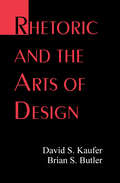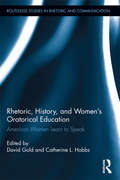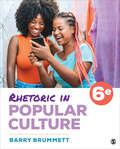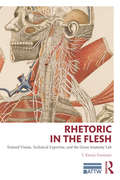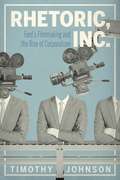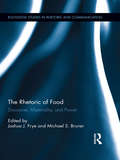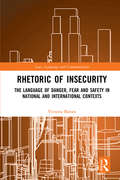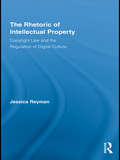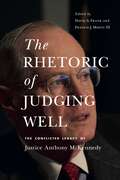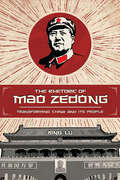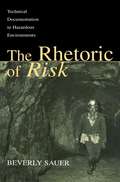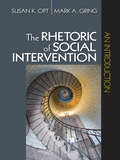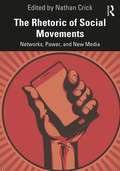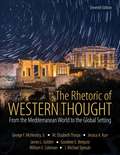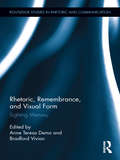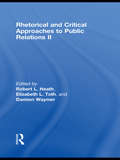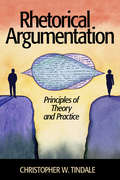- Table View
- List View
Rhetoric and the Arts of Design
by David S. Kaufer Brian S. ButlerThe design arts -- from the design of buildings and machines to software and interfaces -- are associated with types of knowledge and performance thought to be structured, modular, and systematic. Such arts have become increasingly prestigious in our technocratic society. Since Aristotle, the art of rhetoric was conceived as a loosely structured "practical" art thought to be limited in the extent to which it could mimic more precise subject matters. The art of rhetoric has been controversial since classical times, but its status has sunk even lower since the industrial revolution -- a point when civic cultures began to cede authority and control to the cultures of specialized experts. Many sympathizers of rhetoric have resisted its decline by calling for a civic art of public discourse to stand in opposition to a technocratic specialized discourse that has come, increasingly, to disenfranchise the ordinary citizen. This is the first book to question the rhetoric/technical knowledge split from a more fundamental perspective. To get some perspective on what is at stake in rhetoric's traditional classification as a "practical" art, the authors: * explore the distinction between practical and design arts; * enumerate the various criteria cited in the literature for qualifying a cluster of knowledge and performative skills to count as an art of design; * show how the knowledge and performative skills associated with the art of rhetoric meet the major requirements of design knowledge; * propose a general architecture of rhetorical design, one descriptive both of civic address and specialized academic argument; * turn to the Lincoln/Douglas debates to embody and provide some empirical support and illustration for their architecture; * demonstrate how Lincoln and Douglas can be thought of as expert designers whose rhetoric is highly structured and modular; and * explain how the rhetoric of both rhetorical agents can be represented in the layers and modules that one needs to display plans for buildings, software, or other design artifacts. These layers and modules are not just post hoc annotations of the debates; they also illuminate new and systematic ways for viewing the debates -- and by implication, other specimens of rhetoric -- in terms of strategies of artistic production. Kaufer and Butler conclude their presentation by citing some of the research and educational implications that follow from housing rhetoric within the family of design arts.
Rhetoric, Cultural Studies, and Literacy: Selected Papers From the 1994 Conference of the Rhetoric Society of America
by John Frederick ReynoldsThis volume presents a representative cross-section of the more than 200 papers presented at the 1994 conference of the Rhetoric Society of America. The contributors reflect multi- and inter-disciplinary perspectives -- English, speech communication, philosophy, rhetoric, composition studies, comparative literature, and film and media studies. Exploring the historical relationships and changing relationships between rhetoric, cultural studies, and literacy in the United States, this text seeks answers to such questions as what constitutes "literacy" in a post-modern, high-tech, multi-cultural society?
Rhetoric, Fantasy, and the War on Terror (Routledge Studies in Media, Communication, and Politics)
by Vaheed RamazaniThe book draws on psychoanalytic and semiotic perspectives to examine popular, political, legal, and journalistic discourses mediating the War on Terror. The analysis encompasses governmental speeches, legal documents, print and broadcast journalism, and military memoirs under the Bush, Obama, and Trump administrations. Dominant motifs include American exceptionalism and its historical affinity for war, the synergy between the technologies of war and media, the role of the "military-industrial-media-entertainment network" in promoting the American culture of militarism, the dialectic of identification and repulsion in the construction of "the enemy," and the political and mediatic normalization of fear. The author explores in particular the role of desire in the rhetorical construction and naturalization of the fantasy of a global War on Terror. Scholars and students alike will take interest in this original contribution to the fields of cultural studies, psychoanalysis, media studies, rhetoric, critical international relations, and international humanitarian law and ethics.
Rhetoric, History, and Women's Oratorical Education: American Women Learn to Speak (Routledge Studies in Rhetoric and Communication)
by David Gold Catherine L. HobbsHistorians of rhetoric have long worked to recover women's education in reading and writing, but have only recently begun to explore women's speaking practices, from the parlor to the platform to the varied types of institutions where women learned elocutionary and oratorical skills in preparation for professional and public life. This book fills an important gap in the history of rhetoric and suggests new paths for the way histories may be told in the future, tracing the shifting arc of women's oratorical training as it develops from forms of eighteenth-century rhetoric into institutional and extrainstitutional settings at the end of the nineteenth century and diverges into several distinct streams of community-embodied theory and practice in the twentieth. Treating key rhetors, genres, settings, and movements from the early republic to the present, these essays collectively challenge and complicate many previous claims made about the stability and development of gendered public and private spheres, the decline of oratorical culture and the limits of women's oratorical forms such as elocution and parlor rhetorics, and women's responses to rhetorical constraints on their public speaking. Enriching our understanding of women's oratorical education and practice, this cutting-edge work makes an important contribution to scholarship in rhetoric and communication.
Rhetoric in Popular Culture
by Barry S. BrummettThe Sixth Edition of Barry Brummett’s Rhetoric in Popular Culture provides readers with in-depth insight into the techniques of rhetorical criticism to analyze the full spectrum of contemporary issues in popular culture. Exploring a wide range of mass media texts including advertisements, magazines, movies, television, popular music, and social media, Barry Brummett presents key rhetorical concepts and applies them with critical analysis to a variety of exciting examples drawn from today′s popular culture. Ideal for courses in rhetorical criticism, the new edition includes new and updated sample critical essays and case studies that demonstrate for readers how the critical methods discussed can be used to study the hidden rhetoric of popular culture.
Rhetoric in Popular Culture
by Barry S. BrummettThe Sixth Edition of Barry Brummett’s Rhetoric in Popular Culture provides readers with in-depth insight into the techniques of rhetorical criticism to analyze the full spectrum of contemporary issues in popular culture. Exploring a wide range of mass media texts including advertisements, magazines, movies, television, popular music, and social media, Barry Brummett presents key rhetorical concepts and applies them with critical analysis to a variety of exciting examples drawn from today′s popular culture. Ideal for courses in rhetorical criticism, the new edition includes new and updated sample critical essays and case studies that demonstrate for readers how the critical methods discussed can be used to study the hidden rhetoric of popular culture.
Rhetoric in the Flesh: Trained Vision, Technical Expertise, and the Gross Anatomy Lab (ATTW Series in Technical and Professional Communication)
by T. Kenny FountainRhetoric in the Flesh is the first book-length ethnographic study of the gross anatomy lab to explain how rhetorical discourses, multimodal displays, and embodied practices facilitate learning and technical expertise and how they shape participants’ perceptions of the human body. By investigating the role that discourses, displays, and human bodies play in the training and socialization of medical students, T. Kenny Fountain contributes to our theoretical and practical understanding of the social factors that make rhetoric possible and material in technical domains. Thus, the book also explains how these displays, discourses, and practices lead to the trained perspective necessary for expertise. This trained vision is constructed over time through what Fountain terms embodied rhetorical action, an intertwining of body-object-environment that undergirds all scientific, medical, and technical work. This book will be valuable for graduate and advanced undergraduate courses in technical and professional communication (technical communication theory and practice, visual or multimodal communication, medical technical communication) and rhetorical studies, including visual rhetoric, rhetoric of science, medical rhetoric, material rhetoric and embodiment, and ethnographic approaches to rhetoric.
Rhetoric, Inc.: Ford’s Filmmaking and the Rise of Corporatism (RSA Series in Transdisciplinary Rhetoric #15)
by Timothy JohnsonIn 1914, the Ford Motor Company opened its Motion Picture Laboratory, an in-house operation that produced motion pictures to educate its workforce and promote its products. Just six years later, Ford films had found their way into schools and newsreels, travelogues, and even feature films in theaters across the country. By 1961, it is estimated that the company’s movies had captured an audience of sixty-four million people.This study of Ford’s corporate film program traces its growth and rise in prominence in corporate America. Drawing on nearly three hundred hours of material produced between 1914 and 1954, Timothy Johnson chronicles the history of Ford’s filmmaking campaign and analyzes selected films, visual and narrative techniques, and genres. He shows how what began as a narrow educational initiative grew into a global marketing strategy that presented a vision not just of Ford or corporate culture but of American life more broadly. In these films, Johnson uncovers a powerful rhetoric that Ford used to influence American labor, corporate style, production practices, road building, suburbanization, and consumer culture. The company’s early and continued success led other corporations to adopt similar programs.Persuasive and thoroughly researched, Rhetoric, Inc. documents the role that imagery and messaging played in the formation of the modern American corporation and provides a glimpse into the cultural turn to the economy as a source of entertainment, value, and meaning.
Rhetoric, Inc.: Ford’s Filmmaking and the Rise of Corporatism (RSA Series in Transdisciplinary Rhetoric #15)
by Timothy JohnsonIn 1914, the Ford Motor Company opened its Motion Picture Laboratory, an in-house operation that produced motion pictures to educate its workforce and promote its products. Just six years later, Ford films had found their way into schools and newsreels, travelogues, and even feature films in theaters across the country. It is estimated that by 1961, the company’s movies had captured an audience of sixty-four million people.This study of Ford’s corporate film program traces its growth and rise in prominence in corporate America. Drawing on nearly three hundred hours of material produced between 1914 and 1954, Timothy Johnson chronicles the history of Ford’s filmmaking campaign and analyzes selected films, visual and narrative techniques, and genres. He shows how what began as a narrow educational initiative grew into a global marketing strategy that presented a vision not just of Ford or corporate culture but of American life more broadly. In these films, Johnson uncovers a powerful rhetoric that Ford used to influence American labor, corporate style, production practices, road building, suburbanization, and consumer culture. The company’s early and continued success led other corporations to adopt similar programs.Persuasive and thoroughly researched, Rhetoric, Inc. documents the role that imagery and messaging played in the formation of the modern American corporation and provides a glimpse into the cultural turn to the economy as a source of entertainment, value, and meaning.
The Rhetoric of Food: Discourse, Materiality, and Power (Routledge Studies in Rhetoric and Communication)
by Joshua J. Frye Michael S. BrunerThis book focuses on the rhetoric of food and the power dimensions that intersect this most fundamental but increasingly popular area of ideology and practice, including politics, culture, lifestyle, identity, advertising, environment, and economy. The essays visit a rich variety of dominant discourses and material practices through a range of media, channels, and settings including the White House, social movement rhetoric, televisual programming, urban gardens, farmers markets, domestic and international agriculture institutions, and popular culture. Rhetoricians address the cultural, political, and ecological motives and consequences of humans’ strategic symbolizing and attendant choice-making, visiting discourses and practices that have impact on our species in their producing, distributing, regulating, marketing, packaging, consuming, and talking about food. The essays in this book are representative of dominant and marginal discourses as well as perennial issues surrounding the rhetoric of food and include macro-, meso-, and micro-level analyses and case studies, from international neoliberal trade policies to media and social movement discourse to small group and interactional dynamics. This volume provides an excellent range and critical illumination of rhetoric’s role as both instrumental and constitutive force in food representations, and its symbolic and material effects.
Rhetoric of InSecurity: The Language of Danger, Fear and Safety in National and International Contexts (Law, Language and Communication)
by Victoria BainesThis book demands that we question what we are told about security, using tools we have had for thousands of years. The work considers the history of security rhetoric in a number of distinct but related contexts, including the United States’ security strategy, the "war" on Big Tech, and current concerns such as cybersecurity. Focusing on the language of security discourse, it draws common threads from the ancient world to the present day and the near future. The book grounds recent comparisons of Donald Trump to the Emperor Nero in a linguistic evidence base. It examines the potential impact on society of policy-makers’ emphasis on the novelty of cybercrime, their likening of the internet to the Wild West, and their claims that criminals have "gone dark". It questions governments’ descriptions of technology companies in words normally reserved for terrorists, and asks who might benefit. Interdisciplinary in approach, the book builds on existing literature in the Humanities and Social Sciences, most notably studies on rhetoric in Greco-Roman texts, and on the articulation of security concerns in law, international relations, and public policy contexts. It adds value to this body of research by offering new points of comparison, and a fresh but tried and tested way of looking at problems that are often presented as unprecedented. It will be essential to legal and policy practitioners, students of Law, Politics, Media, and Classics, and all those interested in employing critical thinking.
The Rhetoric of Intellectual Property: Copyright Law and the Regulation of Digital Culture (Routledge Studies In Rhetoric And Communication Ser. #3)
by Jessica ReymanIn recent years we have witnessed a rising tension between the open architecture of the Internet and legal restrictions for online activities. The impact of digital recording technologies and distributed file sharing systems has forever changed the expectations of everyday users with regard to digital information. At the same time, however, U.S. Copyright Law has shown a decided trend toward more restrictions over what we are able to do with digital materials. As a result, a gap has emerged between the reality of copyright law and the social reality of our everyday activities. Through an analysis of the competing rhetorical frameworks about copyright regulation in a digital age, this book shows how the stories told by active parties in the debate shape our cultural understanding of what is and is not acceptable in the use of copyrighted works on digital networks. Reyman posits recent legal developments as sites of conflict between competing value systems in our culture: one of control, relying heavily on comparisons of intellectual property to physical property, and emphasizing ownership, theft, and piracy, and the other a value of community, implementing new concepts such as that of an intellectual "commons," and emphasizing exchange, collaboration, and responsibility to a public good.
The Rhetoric of Judging Well: The Conflicted Legacy of Justice Anthony M. Kennedy (Rhetoric and Democratic Deliberation)
by David A. Frank And Francis J. Mootz IIIKnown as the “swing justice,” Justice Anthony M. Kennedy provided the key vote determining which way the Supreme Court would decide on some of the most controversial cases in US history. Though criticized for his unpredictable rulings, Kennedy also gained a reputation for his opinion writing and, more so, for his legal rhetoric.This book examines Justice Kennedy’s legacy through the lenses of rhetoric, linguistics, and constitutional law. Essays analyze Kennedy’s opinion writing in landmark cases such as Romer v. Evans, Obergefell v. Hodges, and Planned Parenthood v. Casey. Using the Justice’s rhetoric as an entry point into his legal philosophy, this volume reveals Kennedy as a justice with contradictions and blind spots—especially on race, women’s rights, and immigration—but also as a man of empathy deeply committed to American citizenship.A sophisticated assessment of Justice Kennedy’s jurisprudence, this book provides new insight into Kennedy’s legacy on the Court and into the role that rhetoric plays in judging and in communicating judgment.In addition to the editors, the contributors to this volume are Ashutosh Bhagwat, Elizabeth C. Britt, Martin Camper, Michael Gagarin, James A. Gardner, Eugene Garver, Leslie Gielow Jacobs, Sean Patrick O’Rourke, Susan E. Provenzano, Clarke Rountree, Leticia M. Saucedo, Darien Shanske, Kathryn Stanchi, and Rebecca E. Zietlow.
The Rhetoric of Mao Zedong: Transforming China and Its People (Studies in Rhetoric & Communication)
by Xing LuThis thorough examination of Mao&’s speeches and writings and how they reshaped a nation &“is critical to an understanding of modern China&” (Choice). Mao Zedong fundamentally transformed China from a Confucian society characterized by hierarchy and harmony into a socialist state guided by communist ideologies of class struggle and radicalization. It was a transformation made possible largely by Mao&’s rhetorical ability to attract, persuade, and mobilize millions of Chinese people. In this book, Xing Lu analyzes Mao&’s speeches and writings over a span of sixty years, tracing the sources and evolution of his discourse, analyzing his skills as an orator and mythmaker, assessing his symbolic power and continuing presence in contemporary China, and observing that Mao&’s rhetorical legacy has been commoditized, culturally consumed, and politically appropriated since his death. Applying both Western rhetorical theories and Chinese rhetorical concepts to reach a more nuanced and sophisticated understanding of his rhetorical legacy, Lu shows how Mao employed a host of rhetorical appeals and strategies drawn from Chinese tradition and how he interpreted the discourse of Marxism-Leninism to serve foundational themes of his message. She traces the historical contexts in which these themes, his philosophical orientations, and his political views were formed and how they transformed China and Chinese people. Lu also examines how certain ideas are promoted, modified, and appropriated in Mao&’s rhetoric. His appropriation of Marxist theory of class struggle, his campaigns of transforming common people into new communist advocates, his promotion of Chinese nationalism, and his stand on China&’s foreign policy all contributed to and were responsible for reshaping Chinese thought patterns, culture, and communication behaviors.
The Rhetoric of Pregnancy
by Marika SeigelIt is a truth widely acknowledged that if you’re pregnant and can afford one, you’re going to pick up a pregnancy manual. From What to Expect When You’re Expecting to Pregnancy for Dummies, these guides act as portable mentors for women who want advice on how to navigate each stage of pregnancy. Yet few women consider the effect of these manuals—how they propel their readers into a particular system of care or whether the manual they choose reflects or contradicts current medical thinking. Using a sophisticated rhetorical analysis, Marika Seigel works to deconstruct pregnancy manuals while also identifying ways to improve communication about pregnancy and healthcare. She traces the manuals’ evolution from early twentieth-century tomes that instructed readers to unquestioningly turn their pregnancy management over to doctors, to those of the women’s health movement that encouraged readers to engage more critically with their care, to modern online sources that sometimes serve commercial interests as much as the mother’s. The first book-length study of its kind, The Rhetoric of Pregnancy is a must-read for both users and designers of our prenatal systems—doctors and doulas, scholars and activists, and anyone interested in encouraging active, effective engagement.
The Rhetoric of Risk: Technical Documentation in Hazardous Environments (Rhetoric, Knowledge, and Society Series)
by Beverly A. SauerThe crash of an Amtrak train near Baltimore, the collapse of the Hyatt hotel in Kansas City, the incident at Three Mile Island, and other large-scale technological disasters have provided powerful examples of the ways that communication practices influence the events and decisions that precipitate a disaster. These examples have raised ethical questions about the responsibility of writers within agencies, epistemological questions about the nature of representation in science, and rhetorical questions about the nature of expertise and experience as grounds for judgments about risk. In The Rhetoric of Risk: Technical Documentation in Hazardous Environments, author Beverly Sauer examines how the dynamic uncertainty of the material environment affects communication in large regulatory industries. Sauer's analysis focuses specifically on mine safety, which provides a rich technical and historical context where problems of rhetorical agency, narrative, and the negotiation of meaning have visible and tragic outcomes. But the questions Sauer asks have larger implication for risk and safety: How does writing function in large regulatory industries? What can we learn from experience? Why is this experience so difficult to capture in writing? What information is lost when agencies rely on written documentation alone? Given the uncertainties, how can we work to improve communication in hazardous and uncertain environments? By exploring how individuals make sense of the material, technical, and institutional indeterminancies of their work in speech and gesture, The Rhetoric of Risk helps communicators rethink their frequently unquestioned assumptions about workplace discourse and the role of writers in hazardous worksites. It is intended for scholars and students in technical writing and communication, rhetoric, risk analysis and risk communication, as well as a wide range of engineering and technical fields concerned with risk, safety, and uncertainty.
The Rhetoric of Social Intervention: An Introduction
by Susan K. Opt Dr Mark A. GringAuthors Susan Opt and Mark Gring present the first-ever thorough exploration and discussion of the rhetoric of social intervention model [RSI] (initially conceived by rhetorical theorist William R. Brown) for today's students, scholars, and professionals. This unique communication-based model, compatible with traditional and non-traditional critical approaches, provides readers with a systemic framework for interpreting, analyzing, critiquing, and intervening in social and cultural change from a rhetorical perspective. It offers an easily accessible tool for critically reflecting upon the ongoing process of rhetorical intervention in people's interpretations of needs, relationships, and worldview. Readers will learn to use the RSI model to (1) reflect on their own symbolic natures, (2) identify rhetorical trends that generate social change, (3) critique social interventions, (4) initiate social interventions, and (5) anticipate the side effects of interventional choices. The Rhetoric of Social Intervention: An Introduction includes these key features: A detailed, step-by-step approach to help readers develop their skills in analyzing the communication patterns of social interventions and writing their analysis as a critical essayExamples and exercises to promote an interactive, transformative learning environment and encourage the development of critical thinking skills Service learning activities in every chapter that can be completed as individual, group, or class projects Review questions, exercises, and an "Under the Lens" feature in every chapter to help readers deepen their understanding Student and scholar essays that demonstrate the model's critical application Intended Audience: Ideal for advanced undergraduate and graduate courses in Rhetorical Criticism, Rhetorical Theory, Persuasion, Public Address, Social Movements, and Advocacy Communication, the book's focus on criticism as a tool for interpreting social change makes it an excellent supplement for courses in other communication sub-specialties, such as public relations and advertising, and in related disciplines such as marketing, sociology, political science, management, and not-for-profit management. The book also offers communication practitioners a useful guide for the strategic planning of interventions.
The Rhetoric of Social Movements: Networks, Power, and New Media
by Nathan CrickThis collection provides an accessible yet rigorous survey of the rhetorical study of historical and contemporary social movements and promotes the study of relations between strategy, symbolic action, and social assemblage. Offering a comprehensive collection of the latest research in the field, The Rhetoric of Social Movements: Networks, Power, and New Media suggests a framework for the study of social movements grounded in a methodology of "slow inquiry" and the interconnectedness of these imminent phenomena. Chapters address the rhetorical tactics that social movements use to gain attention and challenge power; the centrality of traditional and new media in social movements; the operations of power in movement organization, leadership, and local and global networking; and emerging contents and environments for social movements in the twenty-first century. Each chapter is framed by case studies (drawn from movements across the world, ranging from Black Lives Matter and Occupy to Greek anarchism and indigenous land protests) that ground conceptual characteristics of social movements in their continuously unfolding reality, furnishing readers with both practical and theoretical insights. The Rhetoric of Social Movements will be of interest to scholars and advanced students of rhetoric, communication, media studies, cultural studies, social protest and activism, and political science.
The Rhetoric of Western Thought: From the Mediterranean World to the Global Setting
by George F. McHendry M. Elizabeth Thorpe Jessica A. Kurr James L. Golden Goodwin E. Berquist William E. Coleman J. Michael SprouleBuilding upon a rich legacy, the new edition of The Rhetoric of Western Thought provides readers with a comprehensive understanding of rhetoric from its inception in the ancient world, to its present day expression in contemporary practice and scholarship. <p><p> The 11th edition gives deliberate attention to the voices, bodies, and humans that are too often forgotten or silenced in the history of rhetoric. <p> For example, women’s contributions to rhetoric in Ancient Greece and the Middle Ages are interwoven into the history of rhetoric, rather than treated as an aside of afterthought which happens too often in retellings of the story of rhetoric.
Rhetoric, Remembrance, and Visual Form: Sighting Memory (Routledge Studies in Rhetoric and Communication)
by Bradford Vivian Anne Teresa DemoThis volume offers a multifaceted investigation of intersections among visual and memorial forms in modern art, politics, and society. The question of the relationships among images and memory is particularly relevant to contemporary society, at a time when visually-based technologies are increasingly employed in both grand and modest efforts to preserve the past amid rapid social change. The chapters in this book provide valuable insights concerning not only how memories may be seen (or sighted) in visual form but also how visual forms constitute noteworthy material sites of memory. The collection addresses this central theme with a wealth of interdisciplinary and international approaches, featuring conventional scholarly as well as artistic works from such disciplines as rhetoric and communication, art and art history, architecture, landscape studies, and more, by contributors from around the globe.
Rhetoric, the Polis, and the Global Village: Selected Papers From the 1998 Thirtieth Anniversary Rhetoric Society of America Conference
by David S. Kaufer C. Jan SwearingenRhetoric, the Polis, and the Global Village represents current thought on the role of rhetoric in various disciplines, and includes such diverse topics as race, technology, and religion, demonstrating the expanding relevance of rhetoric in today's world. The essays included in this volume address the question of the polis in ancient and modern times, gradually converging with the more recent 30-year span between the decade of the Global Village and today's rhetorical rehearsals for a political global economy. Originating from the 1998 Rhetoric Society of America's biennial conference, and representing the 30-year anniversary of the organization, this volume offers to all readers the keynote lectures and selected papers celebrating the universality of rhetoric across cultures. As a benchmark for the scholarship and growth of the rhetoric discipline in recent history, it will be of great interest to scholars in classical and contemporary rhetoric, writing, and other fields in which rhetoric has attained critical significance and influence.
Rhetorical Agendas: Political, Ethical, Spiritual
by Patricia BizzellThis edited collection offers a broad consideration of contemporary rhetorical scholarship, tied to political, ethical, and spiritual themes. Originating from the 2004 conference of the Rhetoric Society of America, the contents of this volume reflects the conference themes of rhetorical agendas in current theory and research. The volume starts off with transcripts of the talks presented by the conference's featured speakers. The essays that follow are organized around five key topics: history, theory, pedagogy, publics, and gender. These chapters address subjects ranging from religious identity to civil rights; from weapons of mass destruction to literacy testing and electronic texts, reflecting the wide array of areas under study across the rhetoric discipline. With contributions from well-known scholars as well as newcomers, the breadth and diversity of this collection make a significant contribution to rhetorical scholarship, and will stimulate additional work. As such, the volume will be of interest to scholars and students in rhetoric studies in speech communication, English, and related disciplines.
Rhetorical and Critical Approaches to Public Relations II (Routledge Communication Series)
by Robert L. Heath Elizabeth L. Toth Damion WaymerThis volume illustrates the application of rhetorical theory and critical perspectives to explain public relations practices. It provides a systematic and coherent statement of the crucial guidelines and philosophical underpinnings of public relations. Rhetorical and Critical Approaches to Public Relations II addresses the rhetorical/critical tradition’s contribution to the definition of public relations and PR practice; explores the role of PR in creating shared meaning in support of publicity and promotional organizational efforts; considers the tradition's contributions to risk, crisis, and issues dimensions of public relations; and highlights ethics, character, and responsible advocacy. It uses a rhetorical lens to provide practitioners with a sense of how their PR campaigns make a contribution to the organizational bottom line.
Rhetorical Approaches to College Writing
by Chelsea A. Skelley Kathleen T. Leuschen Meghan McguireThe book is divided into four sections, each of which emphasizes a general framework within which to consider rhetoric. Rhetorical Foundations seeks to answer two questions: What are we studying, and why does it matter? Rhetorical Approaches examines various considerations we must make each time we communicate. Rhetorical Research offers strategies and rules of thumb for conducting responsible, effective, and comprehensive research to inform our opinions and support our arguments.
Rhetorical Argumentation: Principles of Theory and Practice
by Christopher W. TindaleThe study of argumentation has primarily focused on logical and dialectical approaches, with minimal attention given to the rhetorical facets of argument. Rhetorical Argumentation: Principles of Theory and Practice approaches argumentation from a rhetorical point of view and demonstrates how logical and dialectical considerations depend on the rhetorical features of the argumentative situation. Throughout this text, author Christopher W. Tindale identifies how argumentation as a communicative practice can best be understood by its rhetorical features.
